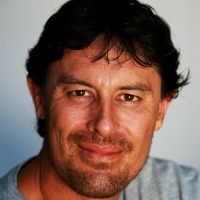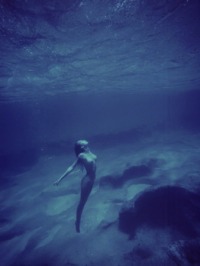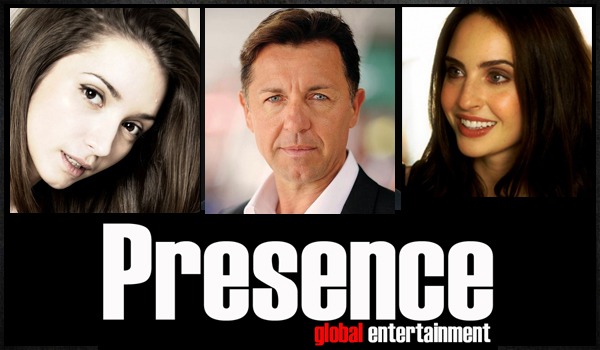

The Sentient Pilot
The Australian franchise of the Sentient story features Royal Australian Navy diver, Lieutenant Commander Michael Dowd, an Indigenous officer and our lead protagonist.
Read the Sentient Pilot.
Do you have an idea or enhancement that would improve the first six pages of the pilot? Log-in and add your idea to the comments section below. Your input shapes the future of the work.
Time starved? Read the summary.
Pilot summary
- Dowd is diving for unexploded ordnance when he encounters an entity
- Dowd wakes in a decompression chamber to discover the facility has been abandoned
- Dowd discovers a pile of bodies and flashbacks to his training
- Dowd senses he is being watched and looks for an escape
- Dowd encounters scientist, Dr. Amon Teicher and sees the storm for the first time
- Dowd and Teicher resolve a plan
- Dowd discovers the pile of bodies has vanished and fears he is hallucinating
- Both experience the full extent of the storm with severe consequences
Missed the first three Sentient posts?
- View Part One – Sentient, (featuring the story model, the synopsis and the science)
- View Part Two – Sentient the why, (featuring an introduction to the theme of colonisation, ‘First time for you’)
- View Part Three – Lore of the Sentient, (featuring the way of and look of the Sentient and an introduction to the Combatants)
Theme
This is a story about colonisation.
What happens when an alien life-form is better at being human than we are?
What happens if they are better for the planet than we are?
Theme and hero
We have chosen an Indigenous Australian as our lead protagonist for the Australian franchise.
We’re not pursuing a political agenda. We’re exploring theme through irony.
Aboriginal Australians have already had to deal with being ‘replaced and surpassed in their own land’.
In Sentient, now it’s the turn of non-indigenous Australians to experience what it feels like and they are not happy.
When Australian leaders lament their great loss, the theft of their land, their culture, their children, Dowd sums up the situation with one response, ‘First time for you?’
Dowd dutifully follows his orders to participate in heinous and extreme acts against the Sentient.
His loyalty to nation and obligations as a Navy officer are constantly tapped by the leadership.
Any questioning of orders is shamed into submission.
He witnesses imprisonment, medical experimentation, exorcisms, slavery, rape, murder and eventually genocide but at some point, a realisation dawns that he is now on the wrong side of this argument and he turns on his leaders.
As an Indigenous doyen, he wakes one morning, walks onto the beach and claims back the land. He turns his back on his leaders and seeks a new way with the Sentient and in doing so becomes an enemy of his own nation.

The Sentient – On being human
The Sentient will discover how unique the human journey is. They will shift from being purely instinct-driven to becoming truly sentient.
Emotionally neutral at the beginning, they become more and more affected by our own chemicals, instincts and needs.
Buddhists say, ‘to want is to feel pain.’
The cool, calm way of the Sentient changes dramatically when they enter into relationships with the survivors. To want for, to long for, to desire, will change them.
Our leaders’ campaign against them will enrage them.
With each slight and every persecution the Sentient will become more and more enraged, eventually surprising the human survivors by adapting the human body in ways that will terrify the survivors and hopefully the audience.
They will become formidable opponents filled with hate and seeking revenge and true to the theme that revenge should be ironic.
The message and final destination
Both sides develop combatants who do not learn, will not change and practice the most heinous acts not only against their supposed enemies but also against each other.
Eventually, those who cannot learn to live with one another and who pursue hate and prejudice will be overcome by a collaboration of the human survivors and the Sentient.
Just like in Battlestar Galactica, the mix of human and the new, represented by the next generation, is the great hope for the future of both life-forms and the planet.
Reveal
The big reveal in Sentient is that this is not the first time they have been here and the link that took us from simple primates to advanced, intelligent beings was borne of a prior visit by the Sentient. The Sentient are predators, they are also the way life spreads throughout the universe.
The conflict model
Leaders may attend the finest private schools, graduate from the most prestigious universities and adopt the most forward-thinking doctrines of the day.
That kind of journey through life tells a person that whatever they are thinking, they are most likely correct.
Shortly after, their assumptions become doctrines and those doctrines get taught back to the next generation in the same universities. Thus, certain values, right or wrong become reinforced as the status quo and the smartest guys in the room end up making the decisions that brought you the Great Depression, the war in Iraq, the GFC, gas fracking and other great ‘fracking’ decisions in history.
What’s the point? Assumptions are dangerous. Assumptions by really smart people are really dangerous.
So, how is this pertinent to the conflict model of Sentient?
Sentient is a story of assumptions made by great, powerful and entitled people that lead to tragedy and lost opportunities.
The Sentient, once they arrive, do not seek to carry-out acts of violence against the human survivors. Far from it, a ‘Lynx’ effect takes place where the Sentient value the survivors’ DNA as they were able to resist their possession. The Sentient seek to mate with the survivors. This is their way throughout the universe however the smartest guys and gals in the room have another take on it.
Nor do the Sentient overpopulate or pollute their environment. They seek balance and to understand their new world.
A mix of ultra-conservatives and religious zealots within the surviving leadership make a series of decisions based on the following assumptions:
- Firstly, that we are about to be invaded
- The Sentient are humans possessed with demons
- Exorcisms will remove the demons
- When exorcisms don’t work, the Sentient are considered, ‘untermensch’
- Medical experiments are carried-out on captured Sentient to determine how they can be modified, altered, trained and enslaved
- When the experiments fail a decision is taken to cull the sentient leading to an all-out genocide. The leadership reason that the Sentient are no different to a pest problem. Bait and burn them
- When the Sentient become aware of what is happening they begin to adapt to the threat
- The Leadership discover that the Sentient are drawn by music so they lure them to a massive cull. Something of great beauty becomes an instrument of evil
- The Sentient begin a series of physical and mental adaptions that create terrifying predators
- The Leadership discover Dr. Amon Teicher’s speciality is biological weapons. Teicher, who has been deemed all but useless by the leadership, suddenly becomes a superstar. He persuades them he can deliver everything they require and can, but will he?
Eventually the survivors find themselves in a life or death struggle against deadly predators and all of borne of their leaders’ own making.
Conflict based on personal relationships between the survivors
What would it look like?
Lieutenant Commander Dowd’s best mate is a Submarine officer called TJ.
TJ’s submarine was 200 metres beneath the surface when the storm arrived. He and his crew have survived.
Both Dowd and TJ’s families live near Jervis Bay Navy base.
Dowd is estranged from his wife but TJ enjoys a strong relationship with his wife and two children. As irony would have it, TJ’s family have all been atomised but Dowd’s wife has become one of the Sentient.
Greater irony follows when Dowd develops a relationship with the Sentient version of his wife and TJ discovers he has lost all.
At this point, TJ only wants to kill the Sentient. He is easily radicalized by the leadership to their objectives and soon finds himself at odds with his best friend Dowd.
Conflict based on the struggle for power
Dowd discovers that the Defence Minister has survived. The Defence Minister is joined by a strong friend, the head of a religious body. They are both conservatives and highly observant of their religious beliefs.
It doesn’t take long for them to reason they have been, ‘chosen to lead’. The Defence Minister assumes the role of the Prime Minister.
When Dowd and TJ arrive in Canberra, they discover the female Minister for Foreign Affairs and Deputy Leader of the party has also survived and has taken up the role of PM in Canberra without the support of the military. She is first in-line for the job but the Defence Minister and his friend have become emboldened and are not willing to surrender their new power.
Conflict between the Sentient
The Sentient become territorial and after the purges, those who forged allegiances with the surviving humans are seen as the enemy of their own.
Conflict model – Conclusion
The surviving leaders are no fools.
They are genuine, fully motivated, people of standing in the community.
Their decisions are well-thought out. They are logical but their doctrines are based on assumptions and prejudices that lead to tragedy.
Each decision they make leaves a gap where the audience would choose to leap in and say, I wouldn’t do that.
The gap lures audiences because they see the great potential and they want to see that realised but it is not, not at least until the end of our series.
Over the horizon – Next post and task
- Expect a mail-out updating the team on new developments shortly
- The new trailer to replace the front page Journey trailer (prep for the shoot)
- Team-up to shoot the look of the Sentient (actors, FX-makeup, crew)
- Call for collaboration on the Australian pilot (writers and think tank)
- Team Moscow franchise – Meet their new characters, read the new scripts
Comments and poll
You can log-in via your social media profile to vote on the two poll questions.
To respond to the bigger issues within the post please log-in to the site and add your comment at the bottom of the page.
Keep your comments, short, sharp and relevant.
If you have more than one point, add them as separate comments.
Your input shapes the future of the work. Have your say.
Polls – The comment function does not work
Please accept our apology, the comment function in the polls does not work. Please vote using the polls but comment using the site comment area at the bottom of the page. Technology, don’t get us started!

This entry was posted on Wednesday, April 8th, 2015 at 2:52 pm
You can follow any responses to this entry through the RSS 2.0 feed.
Tags: alien invasion, Alien life, Australia, colonisation, David Nerlich, David Steinhoff, indigenous, Jillie SImon, Natalia Blajievskaya, Presence Global Entertainment, sci-fi, Sentient, tv series
Posted in: dog, Help, Poll, Sentient, Series Bible, Uncategorized, Writing

On the first read I thought events after scene 1 were taking place on a submarine, but no it’s a hospital. This made me think A: could you get a decompression victim from a sub to a hospital in time? and B: on a sub seemed more exciting/isolated/hazardous etc. On the other hand of course, getting to shoot in a location resembling a sub wouldn’t be cheap or easy.
DN,
Audiences will look at the event under water and then the decomp and say OK, we’ll take that journey because we want to.
Yes, you cannot deliver content that beggars belief BUT audiences also don’t want to be bored so they say, OK we’ll go there, what’s next.
Also, it is almost always a magic trick. You get them focused on the next and they forget or forgive the last.
Re shooting on a sub for other scenes. Working on that.
I think you get away with it.
For a hero in the America region, I would like to suggest a collective group that came together (as opposed to one individual) who demonstrated the meaning of faith, hope and courage in the wake of unimaginable devastation. While the destruction brought out the worst in some, most fought to survive and help others do the same. In the aftermath, they united and rebuilt a city that after the flood many had written off, the city “that care forgot” together in the harshest of conditions. Today the city continues to develop and grow stronger. While there were also leaders and high profile individuals, these were the unsung heroes. While there may be other heroes we know by name, and they are needed, so are the unsung heroes necessary to a society…a good element, I think, for the Sentient.
I am talking about the Hurricane Katrina survivors.
Super. Now, one consideration, the audience in this genre like to lock on one person to start with. You need to give them a focus. Day of the triffids, 28 days later, Walking dead, one person wakes up and has missed the apocalypse. The is who?
Good stuff.
I’m unclear on the meaning of the vanishing bodies – atomisation? Also the eye/nose bleeds – should we have understood what those are yet?
DN,
From the audience’s POV, Dowd has just seen a mermaid then a pile of bodies and Teicher is acting very oddly. They may believe he is hallucinating or that it is just a dream. We leave that open however we did set up the reverse shot of something from the abyss looks back at him.
Later, we will find all of those bodies floating in the harbour for the purge. They are not dead.
Re Atomisation. The Sentient do not eat. They touch and atomise all or some of a substance to achieve nutrient.
They do not overpopulate so when they arrived and have found an unsustainable environment they atomised most of the populace as food whilst they go through their transition stage.
The eye/nose/ ear bleeds – This is from the effect of the storm. It paralyses the brain, stunning it into submission allowing them to travel just like wi-fi into the brain to rewrite the frontal brain and a few other areas.
Teicher and Dowd will experience it but survive.
Of course, the audience may not get all of that yet but as a team member it helps that you get that info upfront.
gotcha.
In which case 1st 6 pages working well and altered my vote accordingly.
Thanks DN. Hope to bring in the collaboration of writers again shortly but had to cut through it to get underway
Hi Dave,
This is particularly fascinating. There are justifications for every action that sets the conflicts in motion.
The Australian’s conflict model is surely awesome. More power to your elbow. And to everyone who contributed too.
Cheers,
Ebuka
Thanks so much Ebuka.
Thanks to Karl Jenner re his advice that helped shape the latest version of the pilot.
Thanks to Jillie Simon for her advice on Sentient and human relationships.
Thanks to David Nerlich. His advice re shaped the conflict model for the Sentients.